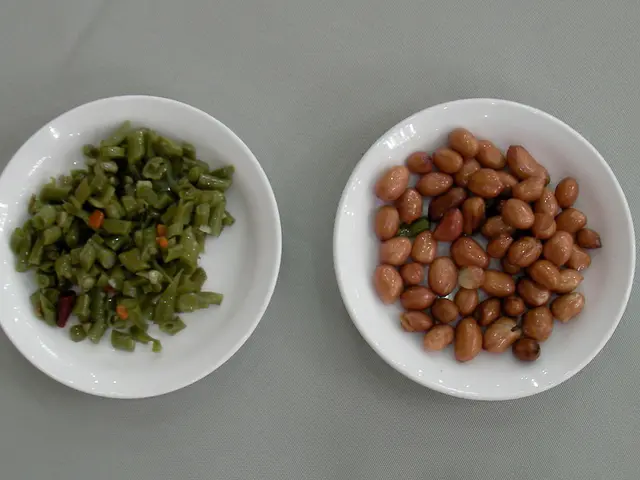Blood Sugar Levels: A Comprehensive Guide - High vs. Low
In the world of diabetes management, it's crucial to comprehend the key differences between hyperglycemia and hypoglycemia. These two conditions, characterised by abnormal blood sugar levels, require distinct management approaches.
Blood Sugar Levels
Hyperglycemia, a state of high blood sugar, typically exceeds 180 mg/dL after a meal or 130 mg/dL fasting, while hypoglycemia, a low blood sugar state, usually falls below 70 mg/dL.
Symptoms
Hyperglycemia symptoms include extreme thirst, frequent urination, blurred vision, fatigue, headache, difficulty concentrating, and in severe cases, symptoms of diabetic ketoacidosis (DKA) such as nausea, vomiting, fruity-smelling breath, rapid breathing, and confusion. On the other hand, hypoglycemia presents with symptoms like shakiness, sweating, hunger, irritability or mood changes, fast heartbeat, lightheadedness or dizziness, and in severe cases, can cause fainting or seizures.
Causes
Hyperglycemia is often caused by missed insulin injections, eating excessive carbohydrates, illness or stress, insufficient exercise, and certain medications like corticosteroids and beta-blockers. Conversely, hypoglycemia is usually caused by taking too much insulin or diabetes medication, skipping or delaying meals, excessive physical activity, or alcohol consumption without food.
Management
Managing hyperglycemia involves administering insulin or glucose-lowering medications as prescribed, adjusting diet and ensuring adequate exercise, monitoring blood sugar levels frequently, and seeking immediate medical care if DKA symptoms appear. Hypoglycemia management requires quick intake of fast-acting carbohydrates such as fruit juice, glucose tablets, soda, honey, or gummy candy to raise blood sugar rapidly, regular monitoring of blood sugar levels, educating patients to recognise early signs to prevent severe episodes, and emergency glucagon injection if the person loses consciousness or has seizures.
Effective blood sugar management involves regular blood sugar checks, being mindful of symptoms, correcting blood glucose when necessary, managing A1C test, blood pressure, cholesterol, smoking, regular exercise, following a diabetes meal plan, and taking diabetes medication as advised. Regular exercise can provide many health benefits, including helping to manage blood glucose.
It's essential to follow the guidelines from your diabetes care team and take your diabetes medication as advised. Consuming a variety of nutritious foods from all food groups and avoiding certain foods, such as those that are fried, high in salt, or have added sugars, can improve overall health.
People can use devices such as finger-prick tests or continuous glucose monitors (CGM) to check their blood sugar levels. An effective strategy to help manage blood sugar is known as the ABCs of diabetes management, which includes an A1C test, blood pressure, cholesterol, and smoking.
In conclusion, understanding hyperglycemia and hypoglycemia is vital for effective diabetes management. Regular monitoring, timely intervention, and a healthy lifestyle can help maintain optimal blood sugar levels and overall health.
- In the world of diabetes management, it's essential to understand the key differences between hyperglycemia and hypoglycemia, two conditions characterized by abnormal blood sugar levels, which require distinct management approaches.
- Hyperglycemia, a state of high blood sugar, typically exceeds 180 mg/dL after a meal or 130 mg/dL fasting, while hypoglycemia, a low blood sugar state, usually falls below 70 mg/dL.
- Hyperglycemia symptoms include extreme thirst, frequent urination, blurred vision, fatigue, headache, difficulty concentrating, and in severe cases, symptoms of diabetic ketoacidosis (DKA) such as nausea, vomiting, fruity-smelling breath, rapid breathing, and confusion.
- Hypoglycemia presents with symptoms like shakiness, sweating, hunger, irritability or mood changes, fast heartbeat, lightheadedness or dizziness, and in severe cases, can cause fainting or seizures.
- Hyperglycemia is often caused by missed insulin injections, eating excessive carbohydrates, illness or stress, insufficient exercise, and certain medications like corticosteroids and beta-blockers.
- Conversely, hypoglycemia is usually caused by taking too much insulin or diabetes medication, skipping or delaying meals, excessive physical activity, or alcohol consumption without food.
- Managing hyperglycemia involves administering insulin or glucose-lowering medications as prescribed, adjusting diet and ensuring adequate exercise, monitoring blood sugar levels frequently, and seeking immediate medical care if DKA symptoms appear.
- Hypoglycemia management requires quick intake of fast-acting carbohydrates such as fruit juice, glucose tablets, soda, honey, or gummy candy to raise blood sugar rapidly, regular monitoring of blood sugar levels, educating patients to recognise early signs to prevent severe episodes, and emergency glucagon injection if the person loses consciousness or has seizures.
- Effective blood sugar management involves regular blood sugar checks, being mindful of symptoms, correcting blood glucose when necessary, managing A1C test, blood pressure, cholesterol, smoking, regular exercise, following a diabetes meal plan, and taking diabetes medication as advised.
- Regular exercise can provide many health benefits, including helping to manage blood glucose, and is beneficial for chronic diseases such as diabetes, cardiovascular health, respiratory conditions, digestive-health, eye-health, skin-care, hearing, mental-health, mens-health, and womens-health.
- Consuming a variety of nutritious foods from all food groups and avoiding certain foods, such as those that are fried, high in salt, or have added sugars, can improve overall health and wellness, as well as fitness-and-exercise, cancer prevention, skin-conditions, aging, parenting, and sexual-health.
- In addition to therapies-and-treatments, it's important to consider medical-conditions like autoimmune-disorders and mental-health, and to follow the guidelines from your diabetes care team to achieve optimal blood sugar levels and overall health.







